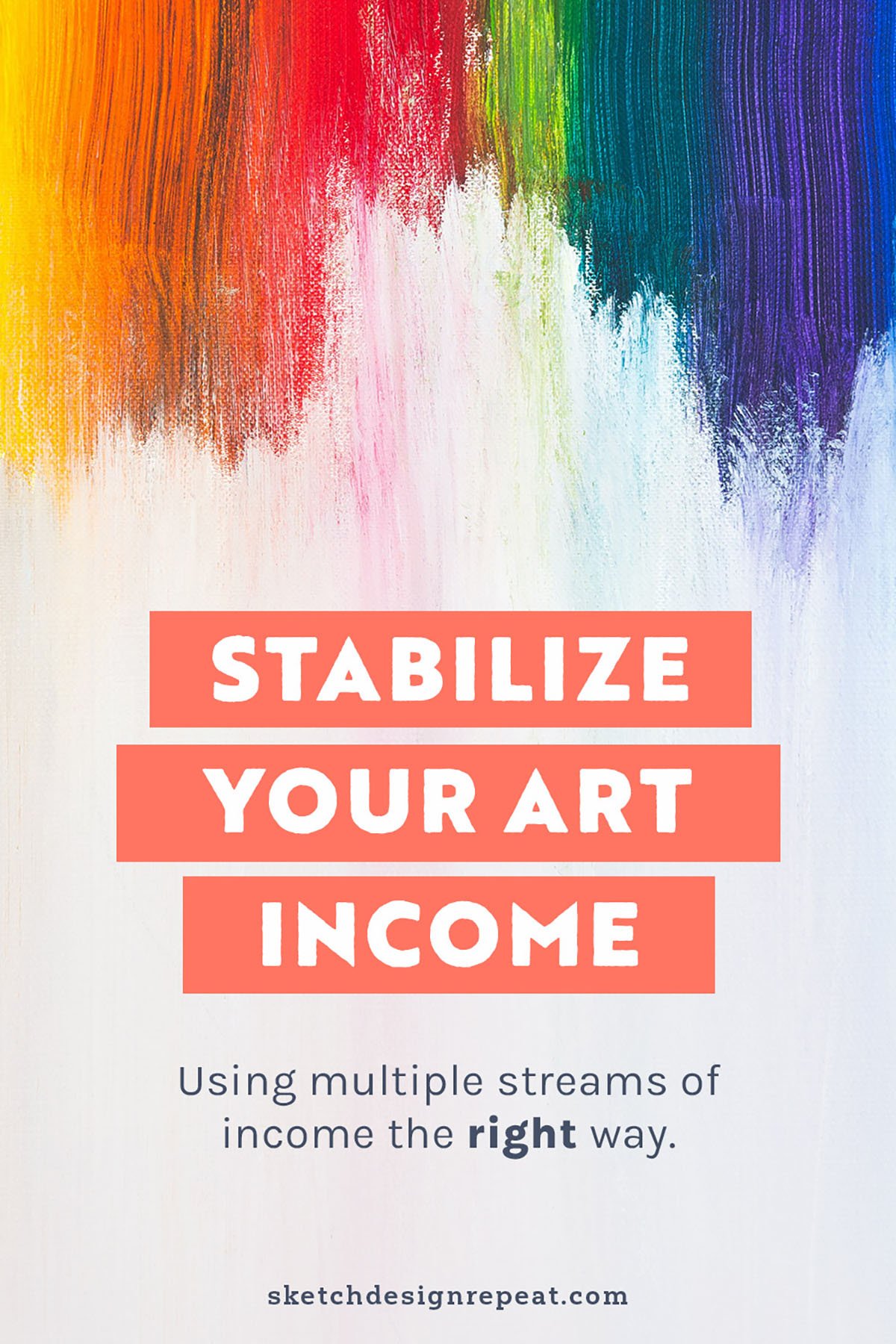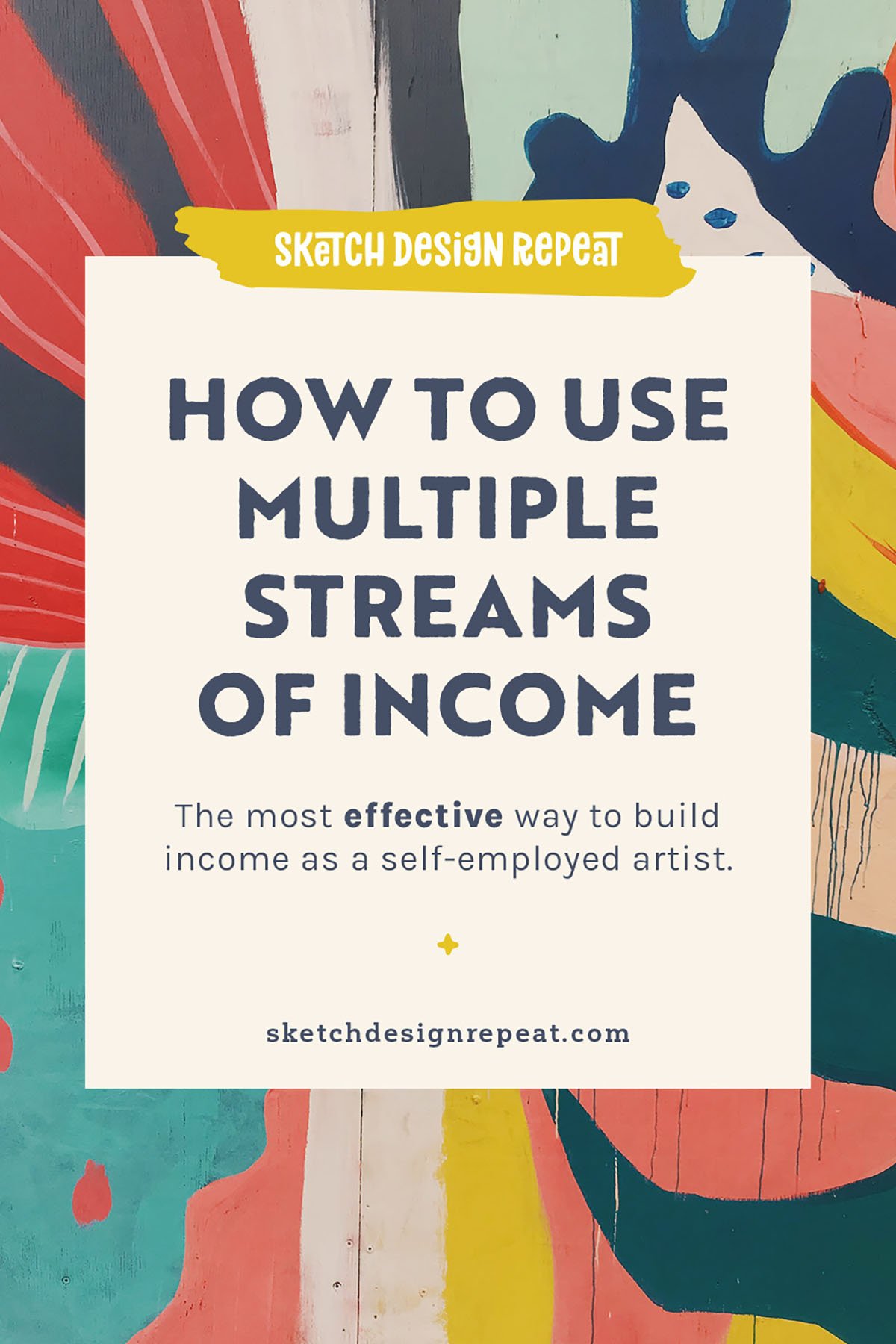Leveraging multiple streams of income as a self-employed artist is an incredibly smart strategy to increase and stabilize your own artist salary. And luckily for us, there’s no shortage of ways to make an income as an artist. Still, some are more popular than others – here are the 7 streams of income that I most commonly see from artists working in the industry:
-
Selling Digital Products
-
Customer Commissions
-
Teaching: Online or in-person workshops
None of these options are inherently better than the others – they all have pros & cons and you can make a living using any blend of them that you like.
But unfortunately, many artists, especially designers new to the industry, try to start too many streams of income at once without a real plan in place for how to grow each.
Maybe a designer starts by trying print on demand. She opens both a Spoonflower & RedBubble store. But then she hears that online classes are really where the money’s to be made, so the next month she creates a Skillshare class. And when she realizes her class only has 22 students after a month, she panics and starts researching how to manufacture her own products or how to get started in art licensing.
And of course, none of her hard work is effective because
-
She didn’t develop a basic plan to decide what avenue was best for her, and
-
She doesn’t have enough time to devote to any single stream of income.
As a result, the designer makes little to no money. Instead, she’s exhausted, confused, and probably seriously considers whether she can ever make a living as an artist.
RELATED ARTICLE: 5 Steps to Set Up Your Surface Design Business
But there’s actually a really simple way to leverage multiple streams of income as an artist that can have a profound effect on your income.
Start with a single income stream.
Believe me, as a fellow multi-passionate artist, I know how difficult it is to only focus on one thing in your business, but you’ll be much better off if you start with only one. But how do you decide which stream of income is right for you?
Step 1: Select 3 Income Streams That Are Appealing
Yes, I know I just told you to choose one in the previous paragraph, but making your decision without knowing more about each first isn’t a very good idea. So choose 3 different streams that sound interesting and take some time to research each one, paying specific attention to the steps that are involved in building that income stream. Make a little list of notes for each.
Step 2: Understanding Your Strengths & Interests
Once you’ve compiled some notes, pull out a fresh piece of paper or Word document and create 2 columns. In the first column, list out all your strengths as a designer and business owner – no detail is too small here.
Then in the second column, write out a list of all your personal interests: what you like to draw, what parts of the business you enjoy, your hobbies, things/places/types of people you like.
Step 3: Narrow It Down to 1 Income Stream
Take the notes you compiled from steps 1 & 2 and look for any crossover or related items between all your notes. Make sure not to rush this process – take a few days to think through everything you’ve written down and what makes the most sense.
For Example: Let’s say you decided to consider print on demand sites, client commissions, and freelance projects as your 3 possible income streams. Then when listing your strengths you put that you’re a thoughtful designer who takes her time creating highly detailed artwork.
Looking at your notes, you notice that print on demand sites work best with simpler, crowd-pleasing designs that you can churn out frequently. Since that runs counter to how you like to create, it would be an easy income stream to cross off your list.
Step 4: Develop a Plan
Some may think you can just create some product, a class, or upload a few designs to a POD site and the platform you’re on will do all the heavy lifting for you, but it’s just not true. While Etsy, Skillshare, or Spoonflower might bring some traffic to you and your art, it’s up to you to do your own marketing and grow your business.
So now that you’ve decided on which income stream you want to start with first, it’s time to set a goal for yourself and build a plan and timeline to help you get there.
But you might be feeling overwhelmed at the thought of creating your own plan and if so, I have a free goal setting worksheet that I’ve used in my own business that can help – it’ll walk you through the entire process from start to finish.
Related Article: My 2020 Income as a Surface Designer
Step 5: Build Your 1st Income Stream, Then Add Another One
After you’ve developed a plan for your first income stream, it’s time to work towards it. And by sticking with a single focus at the start, you’ll be able to pour all your energy into it which is much more efficient than doing too many things at once.
Now how long you stick with your single income focus is up to you (for me it was about 18 months of nothing but surface design before I started creating Skillshare classes), but eventually, you’ll want to add in another one. When that time comes, just go back to step 1 and repeat the process for choosing your 2nd income stream.
Because while it’s important to have a sole focus at the start of your career, you’re unlikely to build a full-time income from a single source. Even if you do (which MAJOR kudos to that), self-employed artist income is usually very volatile and can’t be counted on like if you were employed full-time, so having a few income streams can help stabilize your income month to month and year to year.
So you see, having multiple streams of income is possible and can be very lucrative, as long as you don’t try too many of them at a time.


Oh my. The beginning part of this article described me almost perfectly. Thanks for sharing this information! It is very useful.
Thank you! this is a great guide to help to get focus.
Thank you – love your down to earth approach! I just published my first Skillshare class through a teach challenge and am realizing that the platform is not helping newbies without a social media following at all with marketing (people can only search for popular and trending classes and the algorithm works best for those who are already established). I was super disappointed at first but now am realizing that I actually want to have my class on my own website where I can send people without having to commit to a subscription and where I can control the customer experience a lot more than on a big platform like Skillshare. And yes, that means I will have to get my A into G and look into ways of building an email list and getting back on Instagram and so forth. But I will be building MY brand not someone else’s and that feels a lot more in sync with my values right now.
Thank you for discouraging me to try too many things at once – because I was so frustrated with the experience I was thinking about other income streams to try. I’ll keep your words in mind and go step by step.
This article is super helpful! I’m very appreciative of the time and all of the information you put into this article. You just confirmed my thoughts after having been following and learning from many other creatives over the past 5 years!